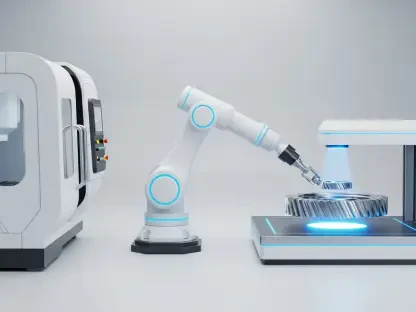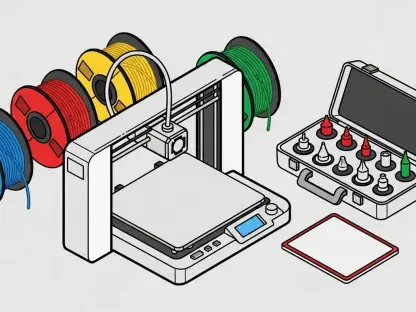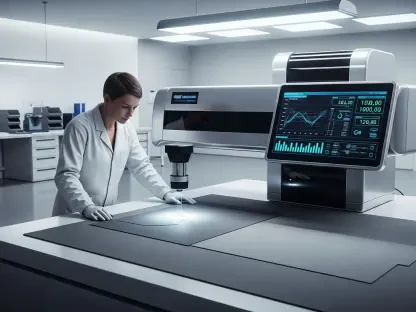Fixed version:
The manufacturing sector is undergoing a significant transformation, driven by the increasing complexity of processes, stringent regulatory standards, and a heightened focus on sustainability. Traditional thermal management systems, where heaters, controllers, sensors, and power units function independently, are becoming insufficient to meet modern demands. This article explores how Integrated Thermal Loops can revolutionize modern manufacturing by offering precision, efficiency, and real-time insights.
The Need for Integrated Systems
Rising Complexity and Regulation
The intricate nature of modern manufacturing processes necessitates sophisticated thermal management solutions to ensure precision and compliance with regulatory standards. As industries evolve, they encounter more nuanced and diverse requirements, making comprehensive systems indispensable. For instance, advanced manufacturing facilities in sectors such as aerospace and automotive must maintain strict temperature controls to ensure component reliability and longevity.
These stringent demands result from increasingly complex product designs and higher performance expectations. Regulatory bodies also play a significant role, imposing rigorous standards to safeguard quality and safety. The necessity for compliance with directives like AMS2750, CQI-9, and ISO 20431:2023 necessitates thermal management systems capable of providing detailed documentation and precise temperature control. Therefore, manufacturers must invest in integrated systems designed to deliver precise monitoring and control, ensuring they meet all regulatory obligations.
Traditional Systems Are Outdated
Legacy thermal management systems fail to meet contemporary demands, leading to operational inefficiencies and increased costs. The old paradigms, where thermal components like heaters, controllers, and sensors operate in isolation, often result in inconsistent performance and frequent breakdowns. The lack of cohesion among these elements makes it challenging to maintain optimal operational conditions, leading to higher energy consumption and significant downtime.
Independently operating systems are also ill-equipped to handle the dynamic nature of modern manufacturing processes. With increasing complexity and precision requirements, manufacturers need systems that can adapt and provide continuous feedback. Traditional setups lack this capability, undermining efforts to enhance efficiency and productivity. Consequently, the need for a more unified and efficient approach has become evident. Integrated Thermal Loops present a solution by combining all critical thermal management components into a cohesive system that operates seamlessly.
Benefits of Integrated Thermal Loops
Real-Time Feedback
Integrated Thermal Loops provide immediate data feedback, which is crucial for maintaining operational control and ensuring precision in manufacturing processes. Real-time insights enable operators to make informed decisions promptly, adjusting parameters as necessary to maintain optimal conditions. The continuous flow of data helps identify potential issues before they escalate, ensuring smoother operations and reducing the risk of costly disruptions.
The ability to monitor and adjust thermal conditions in real-time also proves invaluable in maintaining product quality and consistency. In industries where even minor deviations can have significant consequences—such as pharmaceuticals or semiconductors—having a system that offers instant feedback and rapid adjustment capabilities is a significant advantage. By harnessing real-time data, Integrated Thermal Loops enable manufacturers to uphold stringent quality standards, ensuring that every product meets or exceeds regulatory and customer expectations.
Improved Efficiency
Combining heaters, controllers, sensors, and power units into a cohesive ecosystem significantly boosts efficiency. When these elements work in synergy, the entire thermal management process becomes more streamlined and effective. Integrated Thermal Loops eliminate the disjointed and often inefficient nature of traditional systems, allowing for better coordination and harmonization of thermal processes.
This integration translates into substantial operational improvements. By ensuring that all components function optimally and collaborate seamlessly, Integrated Thermal Loops reduce energy consumption and enhance the overall productivity of manufacturing operations. Because the system can dynamically adapt to changing conditions and requirements, it minimizes process variation and downtime, delivering consistent performance. The enhanced efficiency directly impacts the bottom line, with reduced operational expenses and increased output proving the value of transitioning to integrated systems.
Addressing Operational Inefficiencies
Consistency and Performance
Integrated Thermal Loops play a crucial role in mitigating operational inefficiencies, particularly those relating to process drift, inconsistency, and unplanned downtime, which are critical issues in high-stakes industries like aerospace and automotive. These industries often operate within extremely tight tolerances, where even slight variations in thermal conditions can result in substantial performance degradation or outright failure of components.
By providing a unified approach to thermal management, Integrated Thermal Loops ensure that all aspects of temperature control are meticulously monitored and adjusted in real-time. This results in a significant reduction in variability, leading to more consistent process outcomes and greater product reliability. Furthermore, the system’s ability to predict and preempt disruptions helps to drastically cut down on unplanned downtime, ensuring that critical processes remain operational and productive for longer periods. This proactive maintenance capability safeguards against unexpected equipment failures, enhancing overall operational efficiency and reducing maintenance costs.
Predictive Maintenance
Systems like Watlow’s THERMALWATCH utilize IoT gateways to predict maintenance needs, thus minimizing disruptions and extending equipment life. Predictive maintenance leverages real-time data to foretell when components are likely to fail or require servicing, allowing manufacturers to address issues preemptively rather than reactively. This approach ensures that maintenance activities are performed just in time, preventing unexpected breakdowns and optimizing the use of resources.
The predictive capabilities of Integrated Thermal Loops mean that maintenance schedules can be based on actual usage and wear, rather than arbitrary intervals. This targeted approach not only enhances the reliability and longevity of equipment but also minimizes unnecessary maintenance activities, reducing costs and operational downtime. Moreover, by continuously analyzing system data, manufacturers gain valuable insights into performance trends and potential failure modes, furthering their ability to maintain optimal operational conditions and expedite the resolution of any emerging issues.
Regulatory Compliance
Meeting Standards
The committee reviewed the project’s progress against the predetermined standards and found several areas requiring improvement.
Ensuring compliance with rigorous standards such as AMS2750 and ISO 20431:2023 requires detailed documentation and precise temperature control. Integrated Thermal Loops are particularly adept at meeting these stringent requirements due to their ability to provide comprehensive monitoring and control. By integrating all thermal management components, these systems can deliver the precise temperature regulation needed to comply with industry-specific standards.
The real-time feedback provided by Integrated Thermal Loops is essential in maintaining the accurate records required for compliance. Detailed logging of process data allows for thorough documentation of thermal conditions, which is integral during audits and inspections. This capability not only ensures that processes adhere to regulatory requirements but also enhances overall accountability and transparency. Manufacturers can confidently operate within the confines of industry regulations, knowing that their thermal management systems support rigorous compliance and quality assurance efforts.
Detailed Process Monitoring
Integrated systems offer comprehensive monitoring, which is essential for adhering to industry-specific regulations. Manufacturing environments often require meticulous control over thermal processes, and Integrated Thermal Loops facilitate this through continuous and detailed oversight. These systems enable the monitoring of various parameters such as temperature, pressure, and humidity, ensuring that all conditions remain within specified limits.
This level of detailed process monitoring also facilitates quick identification and rectification of deviations, preventing minor issues from escalating into significant compliance breaches. The integrated nature of these systems means that all data is centralized and easily accessible, streamlining the audit process and ensuring that compliance documentation is accurate and up-to-date. Enhanced monitoring capabilities not only support regulatory adherence but also contribute to overall operational excellence, fostering a culture of continuous improvement and quality assurance within the manufacturing environment.
Case Studies
Semiconductor Manufacturing
In semiconductor manufacturing, analyzing thermal system data plays a critical role in identifying issues such as cold spots, which can disrupt processes and lead to substantial costs. One notable example involved a facility experiencing frequent downtime due to condensation and clogged lines. By leveraging the data provided by an Integrated Thermal Loop, engineers were able to pinpoint the problematic areas and implement additional control zones. This optimization extended maintenance intervals from two weeks to 26 weeks, resulting in significant cost savings and improved operational efficiency.
This case study underscores the value of real-time data analysis in enhancing manufacturing processes. The ability to swiftly identify and address thermal inefficiencies not only boosts productivity but also ensures better yield and product quality. Moreover, the improvements brought about by integrated systems can lead to considerable financial savings, demonstrating the tangible benefits of transitioning from traditional to Integrated Thermal Loops.
Maintenance Insights
Post-maintenance increases in energy consumption without corresponding temperature changes often indicate potential insulation issues, highlighting the diagnostic power of Integrated Thermal Loops. In one instance, an uptick in power usage was detected after routine maintenance, despite no changes in the monitored temperatures. This anomaly suggested an insulation problem, which was promptly addressed, thereby restoring optimal energy efficiency.
Such insights are invaluable in maintaining high operational standards and preventing inefficiencies. The ability to detect and diagnose issues accurately ensures that maintenance activities are focused and effective. Integrated Thermal Loops provide a level of diagnostic capability that traditional systems cannot match, making them indispensable for modern manufacturing environments. By continuously monitoring and analyzing data, these systems empower operators to maintain peak efficiency and swiftly address any deviations from normal operating conditions.
Enhancing Control Systems
Unique Solutions
Watlow’s POWERGLIDE Controller represents a unique solution in the realm of thermal management, particularly in semiconductor manufacturing. This controller is adept at balancing heating elements, which significantly enhances thermal uniformity and device reliability. Uniform heating is critical in semiconductor processing, where even minor temperature variations can lead to defects and reduced yield.
The POWERGLIDE Controller’s ability to maintain consistent thermal conditions translates to fewer issues such as pedestal cracking, a common problem in semiconductor manufacturing caused by uneven heating. By ensuring thermal consistency, the controller not only improves the quality of the manufactured components but also extends the lifespan of the manufacturing equipment, reducing downtime and maintenance costs. This exemplifies how integrated control systems can be tailored to address specific industry challenges, providing targeted solutions that enhance operational efficiency and product quality.
Boosting Reliability
These systems enhance device reliability by preventing common issues, ensuring smoother and more consistent operations. In industries where precision is paramount, maintaining optimal thermal conditions is crucial for component reliability and operational stability. Integrated Thermal Loops achieve this by providing continuous and precise control over all thermal management aspects, ensuring that variations are minimized and conditions are kept within ideal parameters.
The enhanced reliability brought about by these systems leads to several downstream benefits. Consistent operations mean fewer unexpected failures and less downtime, which is critical for maintaining production schedules and meeting customer demands. Additionally, better thermal management improves the overall efficiency and performance of manufacturing processes, resulting in higher quality outputs and reduced waste. By adopting integrated systems, manufacturers can ensure that their operations remain robust, reliable, and capable of meeting the high standards expected in today’s competitive landscape.
Energy Efficiency and Sustainability
Advanced Analytics
Advanced analytics play a crucial role in achieving energy efficiency and boosting sustainability in manufacturing. Technologies like EPower advanced SCR controllers exemplify this by delivering energy savings over 10%, significantly reducing greenhouse gas emissions. These controllers use sophisticated algorithms to optimize energy usage during thermal processes, ensuring that energy consumption is minimized without compromising performance.
By implementing such advanced analytics, manufacturers can achieve substantial reductions in operating costs while also meeting increasingly stringent environmental regulations. The focus on sustainability not only benefits the environment but also enhances the reputation of businesses as responsible and forward-thinking. Moreover, the energy efficiency achieved through integrated thermal solutions contributes to long-term operational savings, making the investment in these systems both economically and environmentally sound.
Consistent Product Quality
Minimizing variability through Integrated Thermal Loops is essential in achieving consistent product quality. By ensuring precise and stable thermal conditions, these systems help maintain the uniformity and quality of manufactured products. This consistency is vital for industries where even minor deviations can result in significant quality issues, such as in pharmaceuticals or electronics manufacturing.
The ability to consistently meet quality standards directly impacts product reliability and customer satisfaction. Integrated Thermal Loops provide the level of control necessary to maintain high standards, resulting in fewer defects, less rework, and ultimately, higher profitability. As manufacturers strive to deliver top-quality products, the comprehensive control offered by integrated systems becomes a critical asset.
Incremental Adoption
The modular nature of Integrated Thermal Loops allows for cost-effective, step-by-step integration, ensuring compatibility with existing infrastructure. This incremental approach enables manufacturers to phase in advanced thermal management solutions without the need for extensive upfront investment or significant operational disruptions. By adopting these systems gradually, businesses can manage costs more efficiently and adapt their processes progressively.
This modularity also allows manufacturers to tailor the integration to their specific needs, focusing on the most critical areas first and expanding as necessary. This flexibility ensures that the transition to integrated systems is smooth and aligns with operational goals and budgets. As technological advancements continue to unfold, the ability to incrementally adopt and scale integrated solutions ensures that manufacturers remain competitive and adaptive in a rapidly evolving industry landscape.
Alignment with Industry 4.0
Integration with Smart Technologies
The integration of Integrated Thermal Loops with smart technologies such as connected devices, AI-driven analytics, and big data is transforming manufacturing systems, making them smarter and more efficient. These advanced technologies enable manufacturers to gather extensive data and derive actionable insights, enhancing the decision-making process and optimizing thermal management.
Utilizing connected devices ensures that all aspects of the thermal management system communicate seamlessly, providing a holistic view of operations. AI-driven analytics can predict patterns, detect anomalies, and suggest improvements, making the system not only reactive but also proactive. The combination of these technologies ensures that manufacturing processes are optimized for efficiency, reducing waste, and improving overall productivity. The continuous feedback loop created by integrated thermal loops and smart technologies fosters an environment of constant improvement, supporting the principles of Industry 4.0.
Cybersecurity Measures
Ensuring robust cybersecurity measures is crucial for integrated systems, where data protection and compliance with standards are paramount. Integrated Thermal Loops need to safeguard sensitive operational data against cyber threats, ensuring that the information remains secure and unaltered. Compliance with cybersecurity standards such as IEC 62443-4-1/2 is essential in providing this security assurance.
End-to-end encryption, access controls, and regular security audits are vital components of a comprehensive cybersecurity strategy. By implementing these measures, manufacturers can protect their systems from potential breaches and ensure the integrity of their data. This level of security is crucial not only for protecting intellectual property and sensitive information but also for maintaining the trust of customers and stakeholders. With integrated systems now being a vital part of manufacturing operations, robust cybersecurity measures are indispensable.
Edge Computing
Watlow’s Edge Process Management (EPM) platform is a prime example of the shift toward edge computing in thermal management. Edge computing brings processing power closer to the data source, enabling real-time data processing and immediate decision-making. This approach significantly reduces latency and allows for faster responses to changing conditions.
By processing data at the edge, manufacturers can quickly adjust thermal processes based on the latest information, ensuring that operations remain optimal. This real-time capability is essential for maintaining the high standards required in modern manufacturing environments. Edge computing, therefore, represents a critical advancement in thermal management, providing the rapid insights and control needed to stay competitive and efficient in an increasingly data-driven industry.
The Strategic Vision
Unified Approach
The strategic vision for thermal management involves a unified approach combining advanced analytics, predictive maintenance, and robust cybersecurity to optimize operations. This holistic strategy ensures that all aspects of thermal management are integrated and working towards common goals of efficiency, reliability, and sustainability. By leveraging the strengths of each component, manufacturers can achieve a well-rounded and effective thermal management system.
Advanced analytics provide the necessary insights to fine-tune processes and drive continuous improvement. Predictive maintenance ensures that equipment remains in optimal condition, reducing unexpected downtime and extending its lifespan. Robust cybersecurity protects the integrity of the system, ensuring that data remains secure and trustworthy. Together, these elements form a comprehensive strategy aimed at optimizing thermal management and supporting long-term industrial success.
Long-Term Resilience
Solutions like digital twins offer real-time monitoring and optimization, significantly enhancing system resilience and performance. Digital twins create virtual replicas of thermal systems, enabling manufacturers to simulate and analyze their operations in a risk-free environment. This capability allows for detailed analysis and testing of various scenarios, leading to better-informed decisions and more resilient operational strategies.
The real-time monitoring enabled by digital twins ensures that any deviations from ideal conditions are promptly identified and addressed. This enhances the stability and reliability of manufacturing processes, reducing the likelihood of disruptions. By fostering a proactive approach to thermal management, digital twins and similar solutions contribute to the long-term resilience of manufacturing operations, ensuring that they remain robust and adaptable in the face of evolving challenges.
Modularity and Scalability
The manufacturing sector is experiencing a major transformation due to increasingly complex processes, stricter regulatory requirements, and a greater emphasis on sustainability. Traditional thermal management systems—which have heaters, controllers, sensors, and power units operating independently—are no longer sufficient to meet today’s demands. This change is prompting the industry to seek more advanced solutions.
One such promising solution is Integrated Thermal Loops (ITL). Unlike traditional systems, ITLs combine these components into a unified, interconnected network. They offer several key advantages, such as improved precision in temperature control, heightened efficiency, and the ability to provide real-time data insights. This holistic approach means that potential issues can be detected and addressed instantly, leading to reduced downtime and better overall system performance.
In addition, ITLs contribute positively to sustainability efforts. By optimizing the thermal management process, they reduce energy consumption and minimize waste. This not only lowers operational costs but also aligns with environmental regulations and corporate social responsibility goals.
As the manufacturing sector continues to evolve, embracing integrated systems like ITLs can be crucial for maintaining competitiveness while adhering to modern standards and expectations. This shift represents a pivotal step toward smarter and more sustainable manufacturing.









